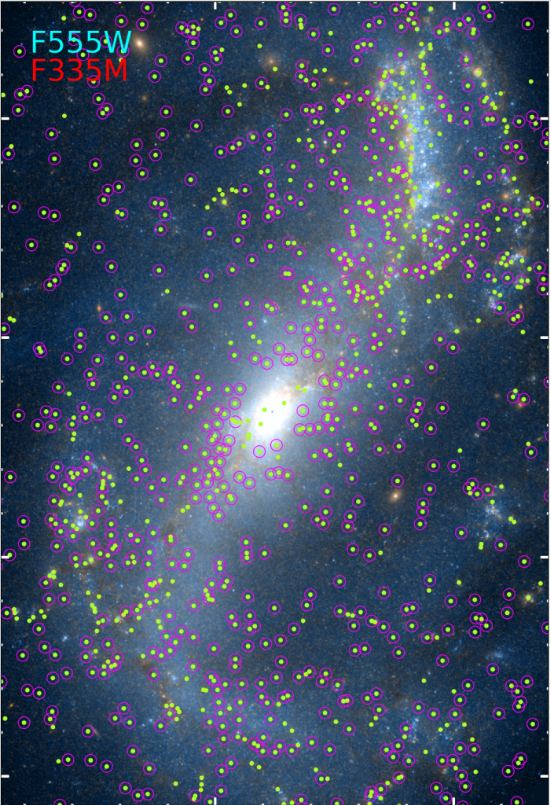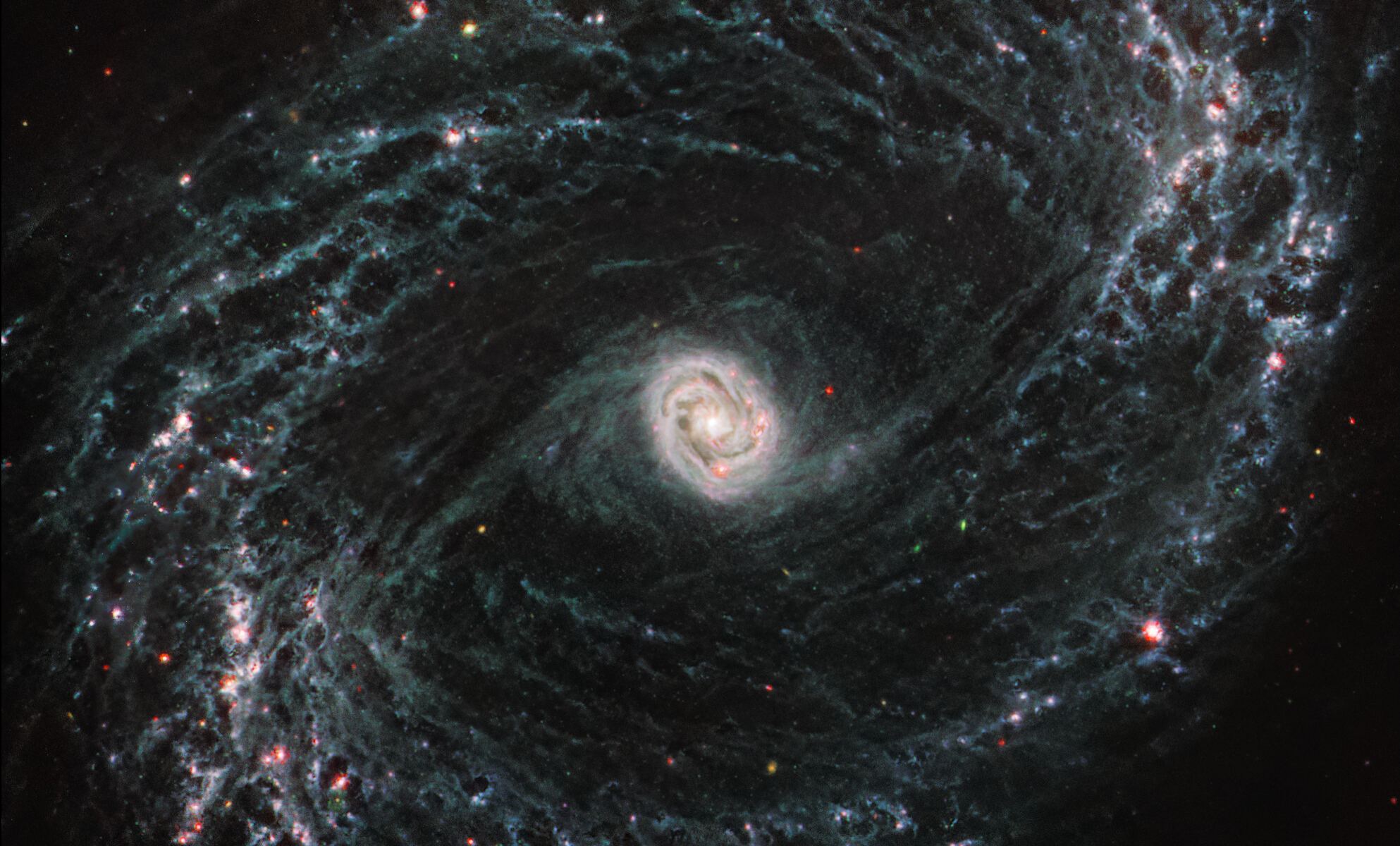Astronomers have studied the star formation process for decades. As we get more and more capable telescopes, the intricate details of one of nature’s most fascinating processes become clearer. The earliest stages of star formation happen inside a dense veil of gas and dust that stymies our observations.
But the James Webb Space Telescope sees right through the veil in its images of nearby galaxies.
The PHANGS (Physics at High Angular resolution in Nearby Galaxies) collaboration is a large survey of nearby spiral galaxies. Its goal is to ” … understand the interplay of the small-scale physics of gas and star formation with galactic structure and galaxy evolution,” according to the PHANGS website.
Telescopes like the Hubble Space Telescope and ALMA have contributed to PHANGS and resolved individual gas clouds and star-forming complexes in galaxies that are the cradles of star birth and the engines of galactic evolution. Now that the JWST is operational, it’s also taking part in PHANGS.
In these PHANGS images, the James Webb Space Telescope is displaying its impressive power once again. The Webb’s high resolution and infrared capabilities reveal new details in the distant spiral galaxies, including intricate networks of gaseous and dusty features. Its observations have led to no fewer than 21 new papers. This is after the telescope has imaged only 5 of its 19 total targets:
- NGC 1433
- M 74
- NGC 7496
- IC 5332
- NGC 1365
The images show galaxies whose spiral arms are nearly frothing with overlapping filaments of gas and dust and bubbles carved out by newly formed stars.
The leading image shows NGC 1433, a barred spiral galaxy with a double-ring structure about 46 million light-years away. Its central region experiences intense star-forming activity. Its spiral arms are also rife with young stars, and the JWST brings it all out in glorious detail. NGC 1433 has an interesting double-ring feature in its core, where tight spiral arms wrap around each other and the bar.
The JWST’s infrared observing prowess brings something new to the table. When very young stars are born, the action is hidden behind a veil of gas and dust. Only once the star has been shining for a while does it blow the veil away with its stellar wind, and astronomers can see the young star. But the JWST doesn’t have to wait. It can see through the gas and dust and give astronomers views of stars much younger than other telescopes can.
The Hubble can’t easily see past the dust like JWST can because the Hubble can’t see mid-infrared photons. When tiny dust grains in galaxies like NGC 1433 absorb UV and optical photons from young stars, the dust grains are heated enough that they produce mid-infrared photos in a process called stochastic heating. The James Webb excels at seeing the mid-IR, and the galaxy’s entire structure is clearer in JWST images because of it.
| Near-Infrared (NIR) | 0.75 – 1.4 micrometres |
| Short-Wavelength Infrared (SWIR) | 1.4 – 3 micrometres |
| Mid-Wavelength Infrared (MIR) | 3 – 8 micrometres |
| Long-Wavelength Infrared (LWIR) | 8 – 15 micrometres |
| Far-Infrared | 15 – 1,000 micrometres |
The Webb image is a dramatic improvement over previous images, and while the visual detail is what grabs most regular eyeballs, the WEBB also gives astronomers a dramatic improvement in scientific detail.

The next galaxy on the list is M 74, a spiral galaxy about 32 million light-years away that’s also known as the Phantom Galaxy. It’s an example of the grand design spiral galaxy type because of its two clearly-defined spiral arms. While the arms of other spiral galaxies can appear muddy and ill-defined, M 74’s arms pop out in sharp relief.

The JWST is not only better at seeing MIR (mid-infrared) photons than other telescopes like the Hubble, but it also has higher angular resolution, meaning small details are more clearly visible. The space telescope’s improved resolution shows how intricate M 74’s structure is, with gossamer-like filaments of gas and dust winding outwards from the center to the galaxy’s grand spiral arms.

M 74 is face-on from our vantage point, making it a valuable target for astronomers. One of M 74’s defining features is its center, or what astronomers call the nuclear region. M 74’s nuclear region lacks the gas common in other spiral galaxies, giving astronomers a clear view of the galaxy’s nuclear star cluster.
The next galaxy is NGC 7496, a barred spiral galaxy about 24 million light-years away. The galaxy’s most notable feature is its active galactic nucleus (AGN.) The supermassive black hole at the center is actively accreting material and heating it up in a swirling disk around the black hole. This makes the AGN visible as the heated material emits photons.

The JWST is so powerful that it can detect PAHs (polycyclic aromatic hydrocarbons) which play a critical role in star formation and in planet formation. They’re organic compounds that form in the clouds of gas and dust that give rise to stars. By sensing them, the JWST allows astronomers to trace the boundaries and details of gas clouds that eventually collapse and form stars.
Some researchers consider the launch of the JWST as the first step in a PAH revolution. Emissions from PAHs encode a lot of information about their surrounding physical and chemical conditions, including star formation. Other telescopes can see PAH regions, but not in the same detail. “JWST’s incredible spatial resolution and sensitivity will disentangle these regions and allow us unprecedented views on PAH characteristics on small spatial scales,” according to Western University.
The JWST also detected 59 new embedded star clusters in NGC 7496. These detections, like other detections in PHANG, are because of the JWST’s ability to see in the MIR better than other telescopes. Embedded clusters contain stars so young that they haven’t blown away the obscuring clouds of gas and dust yet. Their progenitor molecular clouds still surround the stars, and the active star formation taking place inside the clouds is hidden from telescopes like the Hubble. But the JWST easily clears that hurdle.
One of the new papers based on JWST and PHANGS is “PHANGS–JWST First Results: Dust-embedded Star Clusters in NGC 7496 Selected via 3.3 ?m PAH Emission.” As the title makes clear, the JWST’s ability to see PAH emissions is a game changer. “The earliest stages of star formation occur enshrouded in dust and are not observable in the optical. Here we leverage the extraordinary new high-resolution infrared imaging from JWST to begin the study of dust-embedded star clusters in nearby galaxies throughout the Local Volume,” the authors of that paper write.

The next galaxy is IC 5332, an intermediate spiral galaxy about 30 million light-years away. Like M 74, IC 5332 is also face-on from our viewpoint. It has a small central bulge and open arms. It doesn’t have as much star formation activity as some of the other PHANGS galaxies.

The JWST image shows how IC 5332’s symmetrical spiral arms are actually complex webs of gas emitting infrared light at different temperatures. The Webb’s MIRI (Mid-Infrared Instrument) is responsible for this spectacular image, just as it is for the others.
This video shows the difference between Hubble’s view of IC 5332 and the JWST’s view. The Hubble image is hazy and less detailed, though still beautiful and useful.
NGC 1365 is another barred spiral galaxy about 56 million light-years away. It has two bars, with the smaller of the two comprising the galactic core. The inner bar probably rotates faster than the outer bar, creating the diagonal shape. Its pair of prominent arms are more extended than other spiral galaxies.
Recent observations show that the Milky Way is also a barred spiral, so when astronomers study NGC 1365, it also sheds light on the Milky Way. Astronomers think that the bars in these galaxies act almost like a funnel, feeding gas into the galactic center, triggering star formation and the growth of the central black hole.

NGC 1365 is called a starburst galaxy because it’s experiencing an extraordinary amount of star formation. This takes place in the starburst ring, a region in the galaxy’s center. The starburst phase is just one phase of a galaxy’s evolution and uses up so much gas that it’s over relatively quickly. NGC 1365’s complex doube-bar structure helps funnel gas into the starburst ring, triggering a maelstrom of starbirth.
NGC 1365 hosts ” … one of the strongest nuclear starbursts and richest populations of YMCs (Young Massive Clusters) within 20 Mpc.,” according to a new paper examining stellar feedback in the galaxy. These clusters are responsible for a lot of star formation and are hidden inside thick clouds of molecular hydrogen that hide them from other telescopes. But again, the JWST has the capability to see them more clearly due to its MIRI.

The JWST spotted new clusters both in the central region and in the galaxy’s arms. It also shed light on the stellar feedback in the starburst ring, where gas flows in and forms new stars, which then feedback and affect the gas flow. This feedback between stars and the interstellar medium (ISM) is a critical topic in galaxy evolution.

“We find that the gas flowing into the starburst ring from northeast to southwest appears strongly affected by stellar feedback, showing decreased excitation and increased signatures of dissociation in the downstream regions,” the authors of the paper write. Dissociation is when UV light splits molecules into its constituent atoms. “Our results are consistent with a scenario where gas flows into the two arm regions along the bar, becomes condensed/shocked, forms YMCs, and then these YMCs heat and dissociate the gas.”
Even that brief excerpt from new research gives a clue to how complex galaxies and star formation are. When the JWST was in its design phase, scientists identified which questions needed better answers and what instruments and capabilities could generate those answers. Starbirth in galaxies and how galaxies grow and evolve are some of those questions.
One year into its mission, we’re seeing how effective the JWST is at finding deeper answers to our questions. Along the way, we get these beautiful images.

